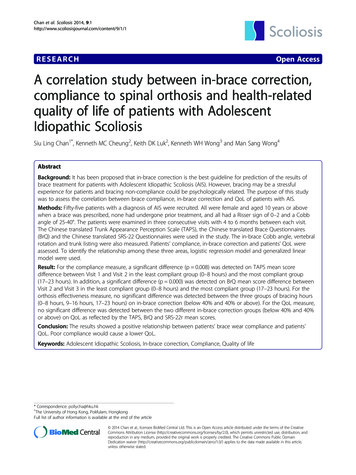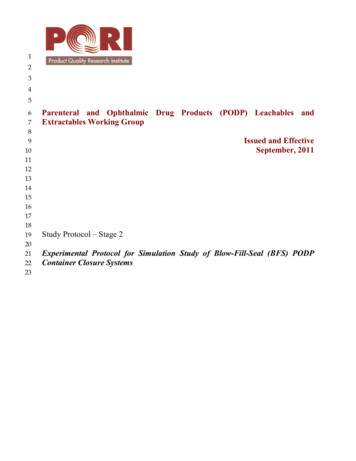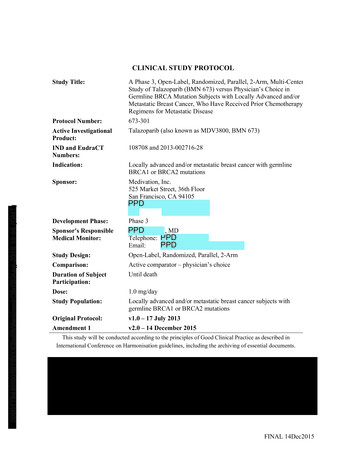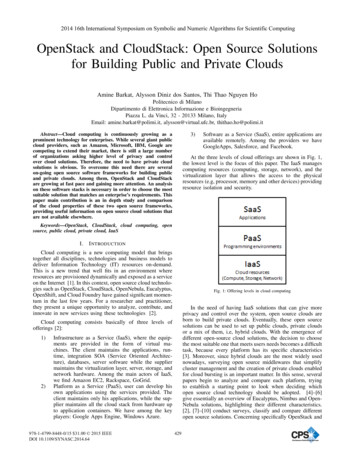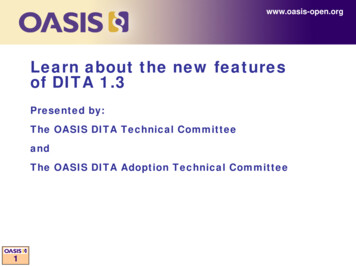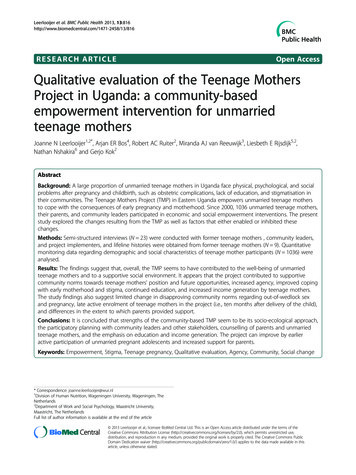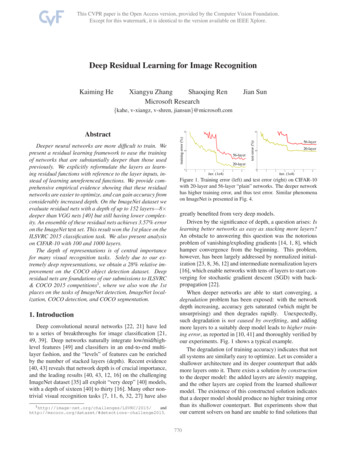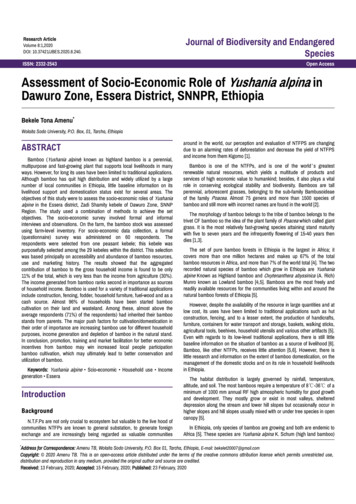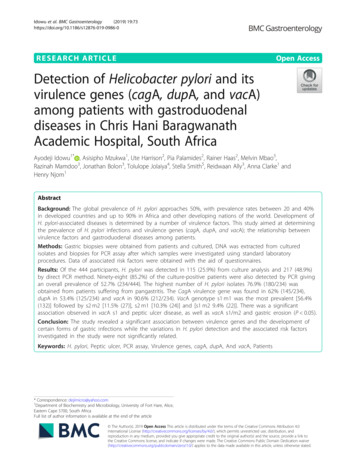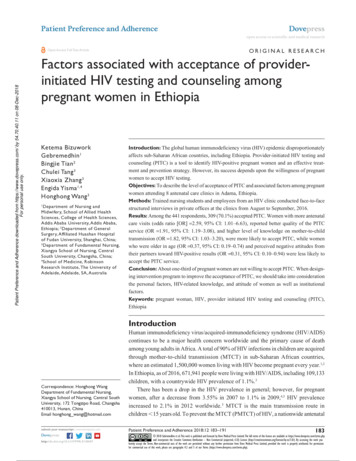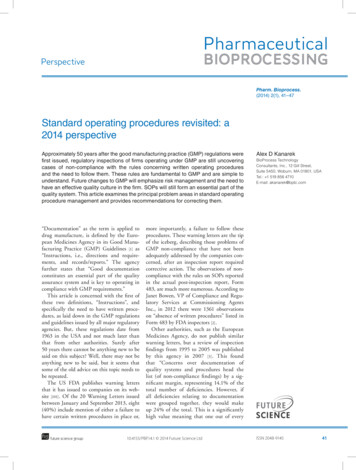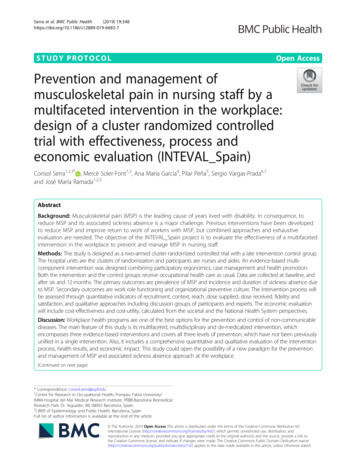
Transcription
Serra et al. BMC Public Health(2019) DY PROTOCOLOpen AccessPrevention and management ofmusculoskeletal pain in nursing staff by amultifaceted intervention in the workplace:design of a cluster randomized controlledtrial with effectiveness, process andeconomic evaluation (INTEVAL Spain)Consol Serra1,2,3* , Mercè Soler-Font1,2, Ana María García4, Pilar Peña5, Sergio Vargas-Prada6,7and José María Ramada1,2,3AbstractBackground: Musculoskeletal pain (MSP) is the leading cause of years lived with disability. In consequence, toreduce MSP and its associated sickness absence is a major challenge. Previous interventions have been developedto reduce MSP and improve return to work of workers with MSP, but combined approaches and exhaustiveevaluation are needed. The objective of the INTEVAL Spain project is to evaluate the effectiveness of a multifacetedintervention in the workplace to prevent and manage MSP in nursing staff.Methods: The study is designed as a two-armed cluster randomized controlled trial with a late intervention control group.The hospital units are the clusters of randomization and participants are nurses and aides. An evidence-based multicomponent intervention was designed combining participatory ergonomics, case management and health promotion.Both the intervention and the control groups receive occupational health care as usual. Data are collected at baseline, andafter six and 12 months. The primary outcomes are prevalence of MSP and incidence and duration of sickness absence dueto MSP. Secondary outcomes are work role functioning and organizational preventive culture. The intervention process willbe assessed through quantitative indicators of recruitment, context, reach, dose supplied, dose received, fidelity andsatisfaction, and qualitative approaches including discussion groups of participants and experts. The economic evaluationwill include cost-effectiveness and cost-utility, calculated from the societal and the National Health System perspectives.Discussion: Workplace health programs are one of the best options for the prevention and control of non-communicablediseases. The main feature of this study is its multifaceted, multidisciplinary and de-medicalized intervention, whichencompasses three evidence-based interventions and covers all three levels of prevention, which have not been previouslyunified in a single intervention. Also, it includes a comprehensive quantitative and qualitative evaluation of the interventionprocess, health results, and economic impact. This study could open the possibility of a new paradigm for the preventionand management of MSP and associated sickness absence approach at the workplace.(Continued on next page)* Correspondence: consol.serra@upf.edu1Centre for Research in Occupational Health, Pompeu Fabra University/IMIM-Hospital del Mar Medical Research Institute, PRBB-Barcelona BiomedicalResearch Park. Dr. Aiguader, 88, 08003 Barcelona, Spain2CIBER of Epidemiology and Public Health, Barcelona, SpainFull list of author information is available at the end of the article The Author(s). 2019 Open Access This article is distributed under the terms of the Creative Commons Attribution 4.0International License (http://creativecommons.org/licenses/by/4.0/), which permits unrestricted use, distribution, andreproduction in any medium, provided you give appropriate credit to the original author(s) and the source, provide a link tothe Creative Commons license, and indicate if changes were made. The Creative Commons Public Domain Dedication o/1.0/) applies to the data made available in this article, unless otherwise stated.
Serra et al. BMC Public Health(2019) 19:348Page 2 of 9(Continued from previous page)Trial registration: Current Controlled Trials ISRCTN15780649 Retrospectively registered 13th July 2018.Keywords: Musculoskeletal pain, Return to work, Cluster randomized controlled trial, Sick leave, Multifaceted intervention,Ergonomics, Case management, Health promotionBackgroundMusculoskeletal pain (MSP) and associated limitationsin mobility and functional capacity are essential characteristics of musculoskeletal disorders (MSDs) [1]. Upperextremity and low back are the most common pain locations. During the last two decades low back pain hasbeen the leading cause of years lived with disability, andits global prevalence and incidence still show an increasing trend [2]. Healthcare workers are an occupationalgroup at high risk of developing MSP [3–5].In Europe, there is evidence that around 70–80% ofworkers report discomfort due to awkward postures andforceful work [2, 3] with an impact not only on healthbut also on work and economy, representing 50% ofsickness absence episodes and 60% of permanent disabilities [6]. This scenario generates new challenges onhealth systems, requiring new strategies for its prevention and management [7, 8].International variations of the distribution of MSP inthe population support that its onset and persistence areinfluenced by a complex and dynamic interactionbetween biological, psychosocial, cultural and also individual factors [9–11]. The biopsychosocial model simultaneously considers all these factors and their impact onhealth and general well-being [12]. Although this modelhas become the dominant framework through which theetiology and prognosis of MSDs is conceptualized, itsapplication into practice has not been optimal [13].Traditionally, the causes of MSDs, and also MSP, havebeen investigated through biomechanics, physiology,genetics, epidemiology and rehabilitation, but separatedfrom other involved relevant disciplines [14]. This fragmented approach does not offer optimal management.Evidence suggests that a combination of several specificapproaches in multi-component interventions that address various determinants of the problem and thosethat incorporate a workers’ participatory approach in theintervention process can obtain better results [15–17].The INTEVAL Spain is an evidence-based intervention and consists of three components: participatoryergonomics (primary prevention of occupational riskfactors), case management (secondary and tertiary prevention) and promotion of healthy lifestyles at work.There is an increasing concern on the so-called participatory ergonomics programs because they are bothmulti-factorial and participatory [18] and are defined asinterventions in the workplace in which the relevantcompany agents actively participate with the aims toidentify and act over the determinants of MSDs [19, 20].Participatory ergonomics programs have been tested inSpanish companies with promising results [21, 22].There is scientific evidence that the management ofmusculoskeletal symptoms through a tailored approachcould be more efficient if individuals are stratified according to certain prognostic profiles in the initial stagesof the disorder and after treatment [23, 24]. At tertiaryprevention, the available scientific evidence suggests thatcase management can reduce the duration of sicknessabsence, musculoskeletal symptoms and disability, andimprove work continuity [25–27]. Integrating activitieson healthy lifestyles at work is also an important component of occupational health programs to reduce MSP[28], so different strategies promoting workers’ physicalactivity, emotional wellbeing and healthy diet [29–32]were also included. As for healthcare workers, promotinghealthy lifestyles should be a priority because of its doubleimpact on their own health and that of patients, encouraging these lifestyles within the general population. Inaddition, the World Health Organization considers workplace as one of the best contexts for the prevention andcontrol of non-communicable diseases [33].This paper presents the design of a study that evaluates the multifaceted INTEVAL Spain intervention inthe workplace in nursing staff from two tertiary hospitalsto prevent and manage MSP and its associated sicknessabsence. We hypothesize that this intervention will beeffective in terms of reducing the prevalence of MSPand will also reduce the incidence of associated sicknessabsence and the time to return to work in the intervention group at the end of the study, compared to the control non-intervention group. In addition, a processevaluation of the intervention and its association withthe impact on MSP, and an economic evaluation will becarried out.MethodsThe CONSORT statement and the extension for clusterrandomized trials were used to describe the design ofthe study [34, 35].Study design and contextThe study is designed as a two-armed cluster randomized trial with a late intervention control group (Fig. 1)where clusters are independent hospital units, and
Serra et al. BMC Public Health(2019) 19:348Page 3 of 9Fig. 1 Flowchart and overview of the trialparticipants are nursing staff (nurses and aides) highlyexposed to ergonomic risk factors at work. There is extensive scientific evidence that incidence and prevalenceof MSP is very high and is the leading cause of sicknessabsence in healthcare workers, especially nurses andaides working in hospitals [36], as it is exposure to ergonomic and other risk factors [37, 38]. It is also wellknown that other non-occupational, cultural and individualfactors also play an important role in the incidence andprognosis of MSP [36]. In Spain, as in other Europeancountries, all employers are required to organize some kindof occupational health service (OHS) according to exposureto occupational risks and company size. The tasks of theseOHS include traditional risk assessment and investigationof occupational injuries, health surveillance mainly throughhealth examinations, prevention, training and informationcovering occupational and non-occupational health risks.External OHS are usually the main occupational healthprovider for small and medium size companies, whereaslarge companies, including hospitals, usually have an inhouse OHS which offer better opportunities for researchand testing new approaches to improve workers‘health.The study is conducted in two main tertiary hospitalsin the cities of Barcelona and Sabadell (Barcelona province) with similar level of health care complexity, aworkforce of around 4000 workers each, of whomaround 60% are nursing staff, and with an experiencedin-house OHS each, that share common methodologiesand good coordination.Recruitment of companiesHospitals had to meet the following criteria to guaranteethe selection of appropriate clusters and the implementation of the intervention: (1) workforce of at least 500workers, (2) commitment and explicit interest from thehospital management to carry out the intervention andits evaluation; (3) existence of an in-house OHS thatmaintains routine quality records and is interested in developing the intervention and; (4) existence of workunits with exposure to significant musculoskeletal risks,as assessed by the OHS.Based on these criteria, two tertiary hospitals with specialized acute care, psychiatry, long-term and primarycare were selected.Recruitment of participantsTo recruit participants, informative sessions were performed at each cluster before disclosing whether theywould be allocated to the intervention or control group,and informed consent and the baseline questionnaireswere obtained from each participant worker. After thesedocuments were filled in and returned, the units were
Serra et al. BMC Public Health(2019) 19:348randomized and informed about their condition of beingintervention or control group, and the interventionstarted. Follow-up questionnaires are administered at sixand 12 months. The questionnaires are anonymous topromote participation and worker’s confidence towardsthe intervention. Anonymized data related to sicknessabsence are collected for the period from 1 year beforethe intervention until the end of the study.Eligibility criteriaThe inclusion criteria are nursing staff (nurses andaides), including employees on sickness absence, whovoluntarily accept to participate. Workers with a temporal contract during a short period, working in severalunits and on sabbatical leave are excluded.InterventionThe intervention covers the three levels of prevention(primary, secondary and tertiary prevention), lasts for 1year and is implemented to the control group thereafter.For primary prevention of occupational risk factors, astandardized procedure of participatory ergonomicsnamed ERGOPAR, developed and previously piloted inSpain is used [39]. A working group (ERGO group) isorganized for each hospital unit, including a specialist inergonomics, the unit supervisor/s, one referent workerfor each shift (morning, afternoon and two night shifts)and one workers’ union representative. This ERGOgroup is responsible for the development and implementation of the intervention, and receive basic training inergonomics and participatory methods. The interventionbegins with the diagnostic phase, with the distribution ofa previously validated self-completed questionnaire inwhich data on MSP and exposure to musculoskeletalrisk factors at work are collected using specific risk assessment. This information is then analyzed and discussed by the ERGO group and a prioritized list of riskfactors is developed. The next step is the treatmentphase, in which the information collected in the questionnaires is shared and discussed with coworkers in theso-called prevention circles. These circles propose a prioritized list of preventive measures aimed to avoid or reduce the identified ergonomic risk factors. This list mayinclude structural, technical, organizational, trainingand/or information measures for improvement, andworkplace modifications. The OHS coordinates the implementation of these measures along with the corresponding department managers. Based on the previousavailable experience with the ERGOPAR method [22],the time required to complete all phases of the intervention in each work unit has been estimated from six to12 months.Secondary and tertiary prevention is carried outthrough a tailored case management intervention.Page 4 of 9Participant workers are voluntarily referred to case management either by themselves, by proposal of theirsupervisor or a physician of the OHS. Workers with aserious underlying organic pathology are excluded fromthis intervention component and managed according tostandard medical practice. A trained case manager assigns participants to three strata of management andtreatment, according to their level of risk for persistentmusculoskeletal symptoms: low, medium or high. Thisprofile is obtained by telephone interview using a questionnaire made of validated tools to generate a risk profile and that assesses the presence of radiated pain,comorbidity, limitations to carry out daily activities,discomfort derived from pain, fear of movement, beliefsand negative expectations regarding the prognosis ofpain, the presence of anxiety and of other mood disorders [23, 24, 38, 40–43]. Workers assigned to thelow-risk group attend an education session on health beliefs related to MSP. Workers assigned to the mediumand high-risk groups receive specific and tailored treatment including rehabilitation, physiotherapy andcognitive-behavioral therapy. In parallel, cases may bediscussed at the weekly clinical session with members ofthe OHS to evaluate possible specific needs at work, asjob adjustments or improvements to help workers tostay and/or early return to work. The case manager contacts all workers regularly to carry out a motivationaltelephone follow-up, and also coordinates the servicesand plan the sessions.An evidence-based program to promote healthy lifestyles at work is also part of the intervention. This program is addressed and offered to all nurses and aides ofthe participating intervention units, and application isvoluntary and free. It includes: (1) mindfulness training,defined as a self-regulation approach to stress reductionand emotional management [44], consisting of anadapted course of 4 sessions of 2 h each on MBRS(Mindfulness-based Stress Reduction) training which hasbeen shown to be effective in healthcare workers [29];(2) Nordic Walking training, defined as a walking technique that uses specially designed poles to actively involve the upper body and arms with wide scientificevidence of its benefits on various health outcomes, including MSP and MSDs [30], offering a program of 12sessions of 1.5 h/session during 12 weeks; and (3) healthyeating based on the Mediterranean diet, as one of thehealthiest dietary models that currently exist [31, 32]consisting on a 3 h session and a web platform.Finally, all components of the intervention are integrated and require coordination by a champion who actsas a leader and facilitator of the intervention, organisingand leading the work to be developed by the study team.His/her tasks involve communication, meetings planning(i.e. informative sessions, and research team meetings),
Serra et al. BMC Public Health(2019) 19:348Page 5 of 9organization of the health promotion activities (i.e. calendar planning), collection and data processing and writing of reports.demands. The score of this questionnaire ranges from 0to 100, being 100 the maximum score (having 100% ofyour functional capacity).Occupational health care as usualOrganizational preventive cultureDuring the intervention period, the OHS of each participating hospital keeps providing the standard occupational health practices for both the intervention andcontrol units. These practices include usual occupationalrisk assessments, investigation of occupational injuries,health surveillance, smoking cessation, training, information and expert assessment in occupational health at alllevels in the hospital (i.e. managers, supervisors,workers), as well as the usual support program for return to work mainly focused on interventions related toworkplace adaptations, clinical support and managementof permanent disability.Organizational preventive culture is measured by the Institute for Work & Health Organizational PerformanceMetric (IWH-OPM) [50]. The IWH-OPM is anevidence-based, eight-item questionnaire used to helporganizations assess and improve their health and safetyperformance and is measured at baseline, six and12-month follow up.Measurements and procedureData are collected by standardized, validated questionnaires, processed in registers and a sample wasdouble-checked to identify inconsistencies and errors.Self-reported questionnaires are administered at baseline, six and 12-month follow-up. Details on processevaluation are also stored in standardized registers,and double-checked. Data of sickness absence will beextracted from the company registries.Primary outcomesPrevalence of musculoskeletal self-perceived painThe Spanish adaptation of the Nordic Questionnairefrom the ERGOPAR Method [45] is used to measureself-perceived MSP in the neck, shoulders and upperback, low back, elbows, hands, legs, knees, and feet,through the dichotomous question “Do you have discomfort or pain in this area?”. Data are collected at baseline, six and 12-month follow-up.Sickness absenceData on episodes and duration of sickness absence dueto a musculoskeletal condition (MSP or MSDs) are collected from the company registries and the OHS duringthe study period and 1 year before the intervention.Secondary outcomesWork functioningWork functioning is measured at baseline, six and12-month follow-up using the Work Role FunctioningQuestionnaire-Spanish Version (WRFQ-SpV) [46–48].This tool is a self-administered questionnaire that measures perceived difficulties in performing one’s job dueto health problems [49] and consists of 27 items dividedinto five subdomains: work scheduling demands, outputdemands, physical demands, mental demands, and socialProcess evaluationThe intervention process will be evaluated based onprevious evidence and indicators for process evaluation[51, 52]: recr
Background: Musculoskeletal pain (MSP) is the leading cause of years lived with disability. In consequence, to reduce MSP and its associated sickness absence is a major challenge. Previous interventions have been developed to reduce MSP and improve return to work of workers with MSP, but
